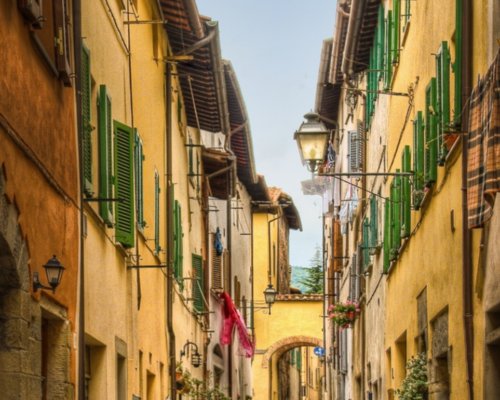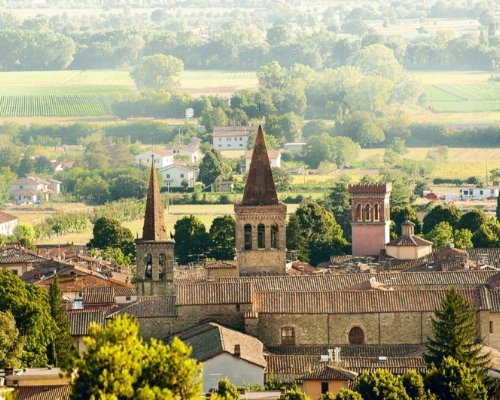Artistic masters, saints and “smoking-hot” heritage
The Valtiberina region takes its name from the Tiber River, which winds its way through Tuscany from Emilia-Romagna and onward into Umbria and Lazio. Think of it simply as the upper Tiber valley: it’s long been associated with the travels of Saint Francis and the artwork of area native son Piero della Francesca, who frequently used his homeland as the artistic basis for his landscapes. Early Renaissance enthusiasts and those curious about religious history will of course be at home here, but the region holds more than a few surprises, too.
Start your Valtiberina adventures in the region’s largest town, Sansepolcro, best known as the birthplace of Early Renaissance master Piero della Francesca and custodian of some of his most famous frescoes. Although remembered primarily as a painter, during his heyday Piero della Francesca was also a mathematician.
The Museo Civico is the “mecca” for those on the Piero della Francesca path. Here you’ll find a high concentration of his frescoes and paintings, including the monumental Resurrection, famous for its allegorical references to the passage of time and the synthesis of science and art. Less instantly recognizable are the artist’s Madonna of the Misericordia polyptych and frescoes of San Giuliano and San Ludovico. In addition to Piero della Francesca’s work, the museum is home to precious pieces by Pontormo and Andrea della Robbia, plus a substantial collection of Santi di Tito’s work.
True art buffs should take the five-minute walk from the museum to the deconsecrated church of San Lorenzo (via Santa Croce 2) to see a stunning altarpiece by a certain late Renaissance-Mannerist redhead. Giovanni Battista di Jacopo, better known as “Rosso Fiorentino” (“the redheaded Florentine”) painted a monumental Deposition here that’s only a hair less lauded than the same scene he painted for the Pinacoteca Comunale of Volterra.
For a break from the typical art-themed itinerary, consider a round of cigar shopping: Sansepolcro has been prime territory for tobacco plant cultivation since at least the 16th century, although historically the cigars themselves were then fabricated in Florence.
Start your Valtiberina adventures in the region’s largest town, Sansepolcro, best known as the birthplace of Early Renaissance master Piero della Francesca and custodian of some of his most famous frescoes. Although remembered primarily as a painter, during his heyday Piero della Francesca was also a mathematician.
The Museo Civico is the “mecca” for those on the Piero della Francesca path. Here you’ll find a high concentration of his frescoes and paintings, including the monumental Resurrection, famous for its allegorical references to the passage of time and the synthesis of science and art. Less instantly recognizable are the artist’s Madonna of the Misericordia polyptych and frescoes of San Giuliano and San Ludovico. In addition to Piero della Francesca’s work, the museum is home to precious pieces by Pontormo and Andrea della Robbia, plus a substantial collection of Santi di Tito’s work.
True art buffs should take the five-minute walk from the museum to the deconsecrated church of San Lorenzo (via Santa Croce 2) to see a stunning altarpiece by a certain late Renaissance-Mannerist redhead. Giovanni Battista di Jacopo, better known as “Rosso Fiorentino” (“the redheaded Florentine”) painted a monumental Deposition here that’s only a hair less lauded than the same scene he painted for the Pinacoteca Comunale of Volterra.
For a break from the typical art-themed itinerary, consider a round of cigar shopping: Sansepolcro has been prime territory for tobacco plant cultivation since at least the 16th century, although historically the cigars themselves were then fabricated in Florence.
Leonardo lovers must visit Anghiari, the town associated with his legendary “lost painting”, which depicted a battle that took place locally in 1440.
But don’t spend the day decoding Da Vinci: instead, take in the many medieval castles—Montauto is a standout, although it’s on a high hilltop and rather difficult to reach. Contemporary Christian pilgrims will cherish this castle, constructed between 1170 and 1180, as a site where Saint Francis of Assisi stayed on his travels toward Verna.
In the afternoon, make the quick ten-minute trip to Monterchi, home to the Madonna del Parto Museum which houses one of Piero della Francesca’s—and perhaps the Renaissance’s—most enigmatic works. The work, the Madonna del Parto or “Pregnant Madonna,” dates from between 1450 and 1465, although the specific patron is unknown. It was painted in the Santa Maria di Momentana chapel in Montione, a site long linked to pagan fertility cults.
Leonardo lovers must visit Anghiari, the town associated with his legendary “lost painting”, which depicted a battle that took place locally in 1440.
But don’t spend the day decoding Da Vinci: instead, take in the many medieval castles—Montauto is a standout, although it’s on a high hilltop and rather difficult to reach. Contemporary Christian pilgrims will cherish this castle, constructed between 1170 and 1180, as a site where Saint Francis of Assisi stayed on his travels toward Verna.
In the afternoon, make the quick ten-minute trip to Monterchi, home to the Madonna del Parto Museum which houses one of Piero della Francesca’s—and perhaps the Renaissance’s—most enigmatic works. The work, the Madonna del Parto or “Pregnant Madonna,” dates from between 1450 and 1465, although the specific patron is unknown. It was painted in the Santa Maria di Momentana chapel in Montione, a site long linked to pagan fertility cults.
Round out the roster of Renaissance masters by spending your third day in Caprese Michelangelo, the humble birthplace of Michelangelo Buonarroti (hence the town’s tack-on of the artist’s first name). While not as dense with artistic treasures as the previous towns, the town’s legacy is reason enough to visit for anyone interested in Michelangelo’s unfussy origins. Don’t skip the Museo Michelangiolesco: one of its three main structures is the Palazzo del Podestà, where the Buonarroti family resided and Michelangelo was born (at the time of his birth, his father was serving as podestà of the Florentine Republic in Caprese Michelangelo, similar to a mayoral role).
The tiny town is also an unexpected hotspot for traditional Tuscan fare: truffle and mushroom-based dishes are particular claims to fame. After you’ve had time to digest a leisurely lunch at one of the down-home trattorias, pop by via Amedeo Andreani to see the stark 13th century church of San Giovanni Battista, site of Michelangelo’s baptism.
Round out the roster of Renaissance masters by spending your third day in Caprese Michelangelo, the humble birthplace of Michelangelo Buonarroti (hence the town’s tack-on of the artist’s first name). While not as dense with artistic treasures as the previous towns, the town’s legacy is reason enough to visit for anyone interested in Michelangelo’s unfussy origins. Don’t skip the Museo Michelangiolesco: one of its three main structures is the Palazzo del Podestà, where the Buonarroti family resided and Michelangelo was born (at the time of his birth, his father was serving as podestà of the Florentine Republic in Caprese Michelangelo, similar to a mayoral role).
The tiny town is also an unexpected hotspot for traditional Tuscan fare: truffle and mushroom-based dishes are particular claims to fame. After you’ve had time to digest a leisurely lunch at one of the down-home trattorias, pop by via Amedeo Andreani to see the stark 13th century church of San Giovanni Battista, site of Michelangelo’s baptism.


